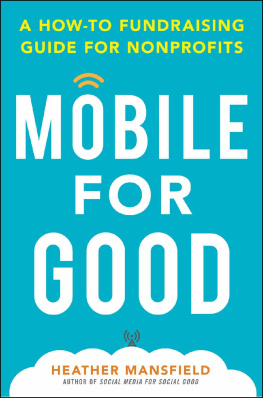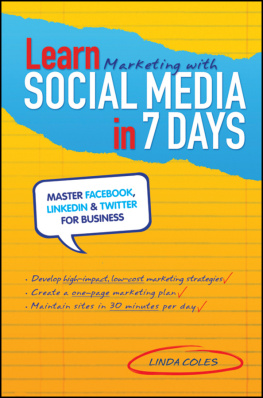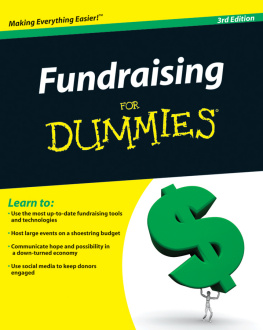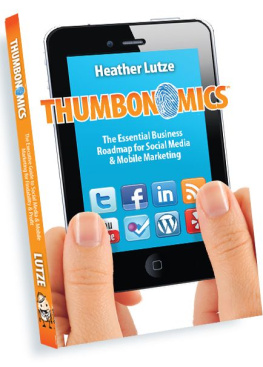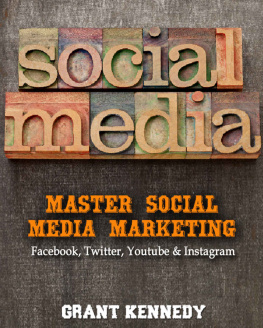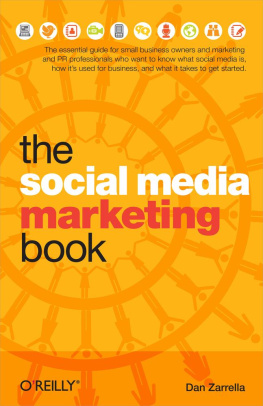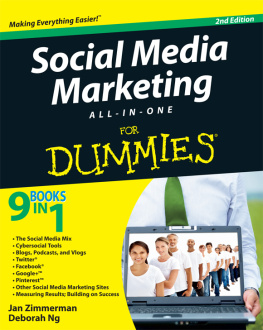SOCIAL MEDIA FOR SOCIAL GOOD
A How-To Guide for Nonprofits
HEATHER MANSFIELD


Copyright 2012 by The McGraw-Hill Companies. All rights reserved. Except as permitted under the United States Copyright Act of 1976, no part of this publication may be reproduced or distributed in any form or by any means, or stored in a database or retrieval system, without the prior written permission of the publisher.
ISBN: 978-0-07-177099-6
MHID: 0-07-177099-2
The material in this eBook also appears in the print version of this title: ISBN: 978-0-07-177081-1, MHID: 0-07-177081-X.
All trademarks are trademarks of their respective owners. Rather than put a trademark symbol after every occurrence of a trademarked name, we use names in an editorial fashion only, and to the benefit of the trademark owner, with no intention of infringement of the trademark. Where such designations appear in this book, they have been printed with initial caps.
McGraw-Hill eBooks are available at special quantity discounts to use as premiums and sales promotions, or for use in corporate training programs. To contact a representative please e-mail us at bulksales@mcgraw-hill.com
Product or brand names used in this book may be trade names or trademarks. Where we believe that there may be proprietary claims to such trade names or trademarks, the name has been used with an initial capital or it has been capitalized in the style used by the name claimant. Regardless of the capitalization used, all such names have been used in an editorial manner without any intent to convey endorsement of or other affiliation with the name claimant. Neither the author nor the publisher intends to express any judgment as to the validity or legal status of any such proprietary claims.
TERMS OF USE
This is a copyrighted work and The McGraw-Hill Companies, Inc. (McGraw-Hill) and its licensors reserve all rights in and to the work. Use of this work is subject to these terms. Except as permitted under the Copyright Act of 1976 and the right to store and retrieve one copy of the work, you may not decompile, disassemble, reverse engineer, reproduce, modify, create derivative works based upon, transmit, distribute, disseminate, sell, publish or sublicense the work or any part of it without McGraw-Hills prior consent. You may use the work for your own noncommercial and personal use; any other use of the work is strictly prohibited. Your right to use the work may be terminated if you fail to comply with these terms.
THE WORK IS PROVIDED AS IS. McGRAW-HILL AND ITS LICENSORS MAKE NO GUARANTEES OR WARRANTIES AS TO THE ACCURACY, ADEQUACY OR COMPLETENESS OF OR RESULTS TO BE OBTAINED FROM USING THE WORK, INCLUDING ANY INFORMATION THAT CAN BE ACCESSED THROUGH THE WORK VIA HYPERLINK OR OTHERWISE, AND EXPRESSLY DISCLAIM ANY WARRANTY, EXPRESS OR IMPLIED, INCLUDING BUT NOT LIMITED TO IMPLIED WARRANTIES OF MERCHANTABILITY OR FITNESS FOR A PARTICULAR PURPOSE. McGraw-Hill and its licensors do not warrant or guarantee that the functions contained in the work will meet your requirements or that its operation will be uninterrupted or error free. Neither McGraw-Hill nor its licensors shall be liable to you or anyone else for any inaccuracy, error or omission, regardless of cause, in the work or for any damages resulting therefrom. McGraw-Hill has no responsibility for the content of any information accessed through the work. Under no circumstances shall McGraw-Hill and/or its licensors be liable for any indirect, incidental, special, punitive, consequential or similar damages that result from the use of or inability to use the work, even if any of them has been advised of the possibility of such damages. This limitation of liability shall apply to any claim or cause whatsoever whether such claim or cause arises in contract, tort or otherwise.
This book is dedicated to all the nonprofit staff and volunteers worldwide who Tweet, Share, Update, Friend, Like, Check-in, Join, Connect, and Post for Social Good. The world is a better place because of you.
CONTENTS
INTRODUCTION
INTEGRATING WEB 1.0, WEB 2.0, AND WEB 3.0
The Internet has come a long way in the last 15 years. Back in 1997, while I was volunteering with a school for street children in Guatemala, I launched my first online fundraising campaign, using only a Yahoo! e-mail account. I had no digital camera or smartphone, no blog or Facebook profile, no PayPal account. None of those tools existed yet. From Internet cafs, I began telling my family and friends the stories of the children and their need for clothing and medicine and asked them to write and snail mail checks to a close friend in California, who then wired the funds to a bank in Guatemala. All told, a little over $400 was raised, which went a long way in Guatemala at the time (and still does) and did a great deal of good for the childrengood that would not have happened had it not been for the Internet.
That experience led me to fall in love with the Web and its potential for social good. I was young(er), passionate, and motivated (and saddened) because so many people were suffering unjustly. I believed deeply that the Internet could change our world for the better and help alleviate that suffering if we could discover ways of using it that would inspire and thus mobilize the masses to take action and to give. I still believe that. I have watched the rise of websites, e-newsletters, donate now technology, and e-mail advocacy in the years that followed that first online fundraising campaign, and those tools have empowered nonprofits like no others before them. It was a very exciting time to be in nonprofit communications and fundraising.
Then came social media. I joined Myspace in 2005, and within three minutes of browsing, I had the exact same epiphanic moment of clarity that I had had with Yahoo! and e-mail fundraisingthis is going to change everything. And it has. Nonprofits and their status updates and tweets have filtered into almost every content area of the Web. Nonprofits have become omnipresent online. They are leading communities of millions worldwide who are unified in the common goal of making life better for people, animals, and the Earth. In the whole scheme of things, 15 years of Internet history is a drop in the bucket, but today, in the era of the Social Web, we are truly beginning to witness and experience the power and potential of the Internet for social good.
Now, in 2011, we are on the brink of yet another great shift in communications and fundraising technology. The Web is going mobile. Without a magic crystal ball, it is almost impossible to know where nonprofit communications will be by 2015, but its thrilling to ponder. There are tools that do not yet exist that will propel nonprofits and connect advocates for social good in ways that our brains cant even imagine yet, and similar to my e-mail fundraising and Myspace moments of clarity, the purchase of my first iPhone in 2009 made me realize yet again, this is going to change everything.
During my professional career, I have experienced the birth of three separate eras of nonprofit Web communications and fundraising. Each era has come with its own unique set of tools and best practices. However, they are complementary in nature. One era does not replace the previous one. In fact, when a nonprofit successfully integrates the tools and best practices from all three eras into one comprehensive, integrated communications and fundraising strategy, the potential for social good is multiplied exponentially. And that, friends, followers, and fans, is the purpose of this book: to help you make sense of these three eras, their distinct tool sets, how they affect one another, and how they can be integrated successfully and cost-effectively to maximize your nonprofits return on investment (ROI) and its contribution to the greater social good. For the sake of clarity, the three eras of nonprofit Web communications and fundraising are defined in this book as follows:


